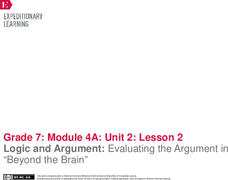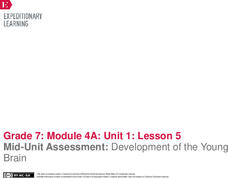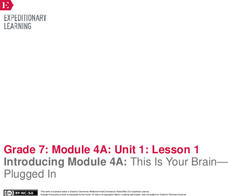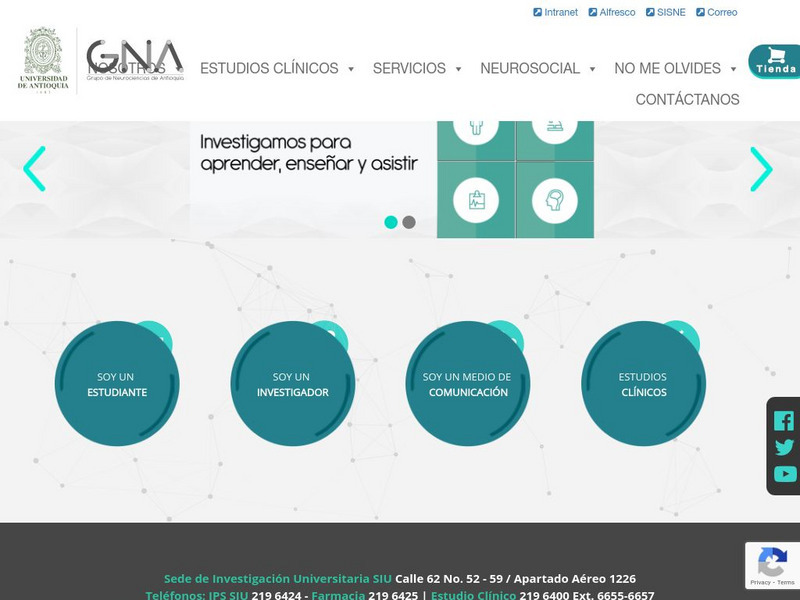University of Minnesota
Do the Stroop
The Stroop test helps diagnose executive function disorders when used in conjunction with other tests. Reading color words and identifying colors seem like basic skills, but the Stroop test may show otherwise. Scholars work with a...
University of Minnesota
Blind Spot
Your eyes each work independently, so how do we only see one image? The quick hands-on experiment encourages young scientists to test their blind spots on each eye individually. After learning where the blind spot is and why it exists,...
K20 LEARN
What Lies Beyond Talent? Mindset And Neuroplasticity
Individuals' views of their learning processes largely affect how they learn. An engaging activity provides your classes with tools to analyze their own views of learning. Using an online game, they explore the concepts related to a...
EngageNY
Logic and Argument: Evaluating the Argument in “Beyond the Brain”
The brain is not the mind. Scholars explore the claim by reading an informational article about neuroscience research, "Beyond the Brain." As they read, they answer text-dependent questions and complete an anchor chart to evaluate...
EngageNY
Mid-Unit Assessment: Development of the Young Brain
Scholars view a video clip about adolescent brain development and work with partners to identify the main idea and supporting details. Next, as part of the mid-unit assessment, pupils watch another clip from the video and complete a main...
EngageNY
Analyzing the Main Idea in Video: Understanding the Limbic System
It's time to put on those thinking caps and analyze the brain! Pupils watch a video about teenage brain development, using a note-catcher to capture their thoughts about the main idea. Finally, they select two pieces of information from...
EngageNY
Comparing Text to Multimedia: Understanding How the Brain Changes
Learners explore how the human brain changes over time, comparing an interactive web page about brain development to a text-only version. Additionally, pupils continue reading an article about teen decision making, analyzing the main...
EngageNY
Identifying Main Ideas and Supporting Details: What’s Going On in the Teenage Brain?
What's going on in the teen brain? Pupils consider the question as they continue reading an informational article about the topic. While reading, they use a Thinking Log worksheet and an anchor chart to track their understanding of...
EngageNY
Introducing Module 4A: This Is Your Brain—Plugged In
What does brain science reveal about teens and decision making? Scholars watch a short video and participate in a gallery walk to pique their interest and curiosity about the topic. Next, they begin reading an informational article about...
College Board
2015 AP® Psychology Free-Response Questions
To what extent is hyperactivity related to sugary treats at a birthday party, and to what extent is it caused by other factors? What goes into a person's adjustment to a new home? Case studies explore questions like these and offer...
College Board
2016 AP® Psychology Free-Response Questions
What conditions influence a student's performance on a high-stakes test? What is the mental health aftermath of a car accident? Case studies examine these and similar questions. Pupils also sharpen their test-taking skills as they work...
College Board
2017 AP® Psychology Free-Response Questions
How does psychology affect other parts of people's lives? Scholars consider scenarios such as how stress affects a musician's audition or to what extent is a person's eating behavior connected to neurology. Analyzing such questions from...
Curated OER
The Brain’s Inner Workings
Do you want to learn about how you learn? Help pupils become the best learners they can be by teaching them how their brain works. The resources available include videos about brain structure and a study guide full of activities that...
University of Washington
University of Wash: Hows, Whats and Whos of Neuroscience
Concise and quick answers to questions about neuroscience and neuroscientists.
National Institutes of Health
Ninds: Coma and Persistent Vegetative State Info Page
Loads of answers to just about any question you may have about comas. This site discusses what coma is, whether there is treatment, what the prognosis might be like, research on comas, and more.
Other
Health Communities: Parkinson's Disease
This site discusses the mystery and complexity of Parkinson's Disease. It mentions the history of the disease, signs and symptoms and incidence.
Famous Scientists
Famous Scientists: Thomas Willis
Thomas Willis was a founding member of the Royal Society, who played an important part in the history of anatomy, neurology, and psychiatry.
WebMD
Web Md: Introduction to Parkinson's Disease
This site from WebMD Health contains a thorough introduction to the causes of Parkinson's Disease, its signs and symptoms, and its atypical variants. The information is fairly in-depth and very interesting in its descriptions.
Other
Neurociencias Para Ninos / Neuroscience for Kids
Learn about the brain and brain science using this Spanish version of the excellent Neuroscience for Kids site. Translation of the site is a work in progress. Portions are in Spanish but links for many pages still lead to the English...
University of Washington
Neuroscience for Kids Other Translations
Translations of Neuroscience for Kids, an excellent site on the brain and brain science by neuroscientists at the University of Washington. Includes Chinese (Mandarin and Cantonese), Portuguese, Italian, Slovene, and Korean. Translations...





















